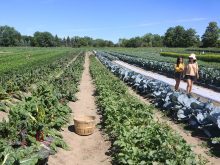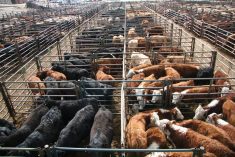CALGARY – After two years of frostbitten crops, the harvest of 1994 has made a turnaround.
Compared to 1993’s production level of 48.7 million tonnes, United Grain Growers’ prairie harvest summary predicts farmers grew 45.2 million tonnes of all crops. But while there seems to be less crop this year, more samples are making the top grades, which gives a better return to farmers.
The biggest growth was in oilseed production, with each of the three Prairie provinces growing 40 percent more canola and flaxseed. More farmers in Saskatchewan switched to these crops than in Alberta or Manitoba.
Read Also

Canada told trade crisis solutions in its hands
Canadians and Canadian exporters need to accept that the old rules of trade are over, and open access to the U.S. market may also be over, says the chief financial correspondent for CTV News.
Saskatchewan grew 6.6 million acres of canola, compared to 4.6 million in 1993. Alberta seeded 5.1 million acres to canola, up from 3.7 million last year and Manitoba upped its canola acreage from 1.8 million to 2.5 million acres.
UGG estimated 7.3 million tonnes of canola will be harvested across the Prairies in 1994. Most of it will grade No. 1 Canada. This is down from Statistics Canada’s July 31 prediction of 8.1 million, but remains a record harvest.
Farmers are expected to take off 972,000 tonnes of flax with 90 percent of it grading in the top category. Statistics Canada said 620,000 tonnes of flax was produced last year.
Higher quality
On the grain side, 21 million tonnes of wheat have been taken off prairie fields. This is 81 percent of the 1993 crop, however, the amount grading No. 1 is considerably higher this fall.
Across Western Canada, 47 percent of red spring wheat made 1CW and 28 percent of the durum also was top grade, compared to more than half of it grading feed in 1992 and 1993.
Weather problems and fusarium damage in Manitoba downgraded red spring wheat and durum for that province, driving down the prairie average.
In Alberta, 72 percent of the durum went 1CW and Saskatchewan reported 22.6 percent making the top grade.
Acceptance of malt barley in the two-row and six-row varieties is higher than the nine-year average – about 10 percent of the barley crop historically grades malt.
Saskatchewan had 35 percent of its two-row go malt and 14.5 percent in the six-row varieties. In Alberta, 14.7 percent of two-row barley and 6.1 percent of six row will be malt. Manitoba had nine percent and 12 percent go malt in the two-row and six-row varieties respectively. Most of the remaining barley crop made No. 1.
While not recorded individually, special crops like peas, sunflowers, canary seed, lentils, beans and mustard increased production by 34 percent. Nearly 4.5 million acres were planted with special crops, as opposed to 3.2 million acres a year ago. Yield figures are not yet available.















